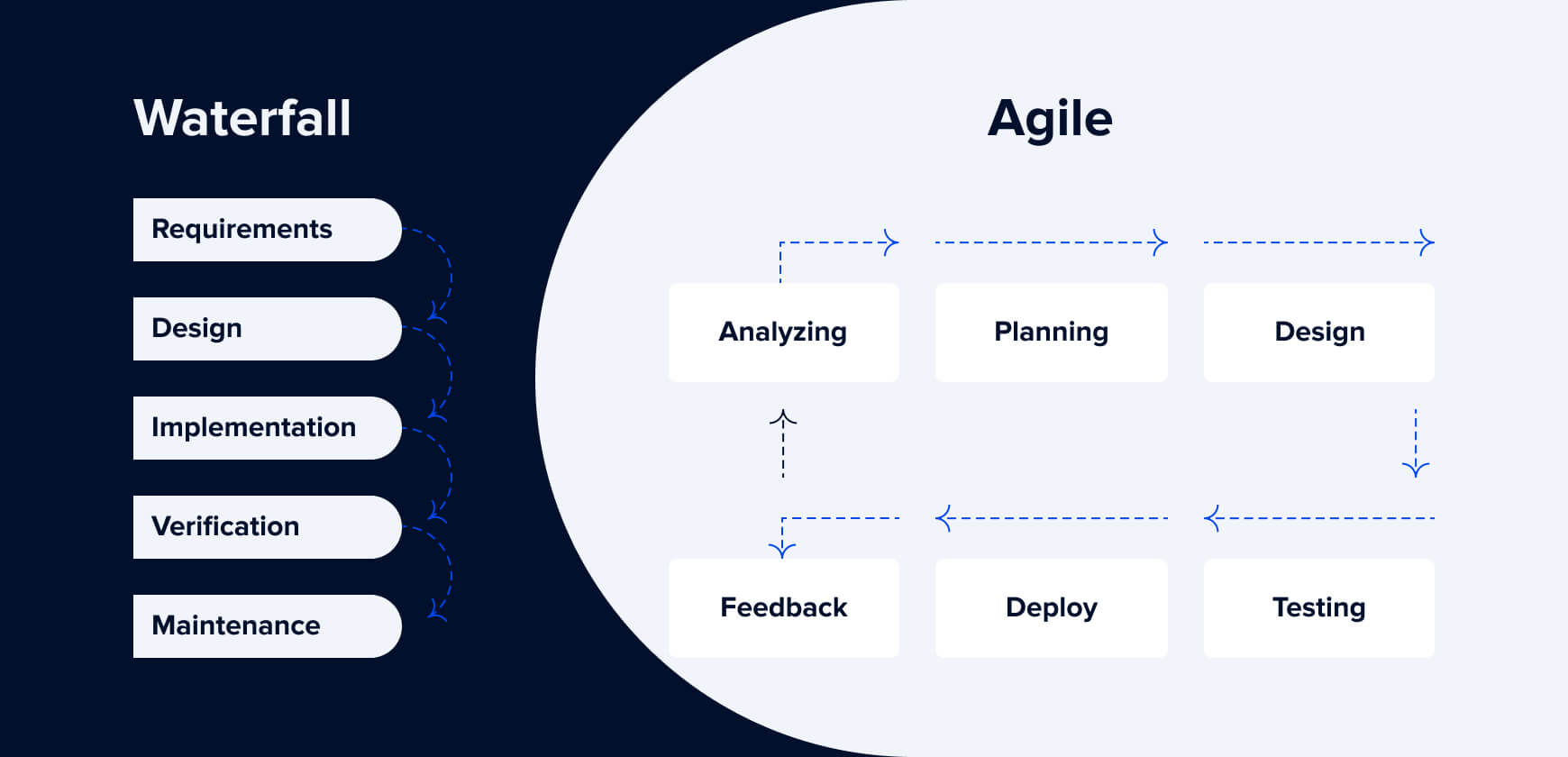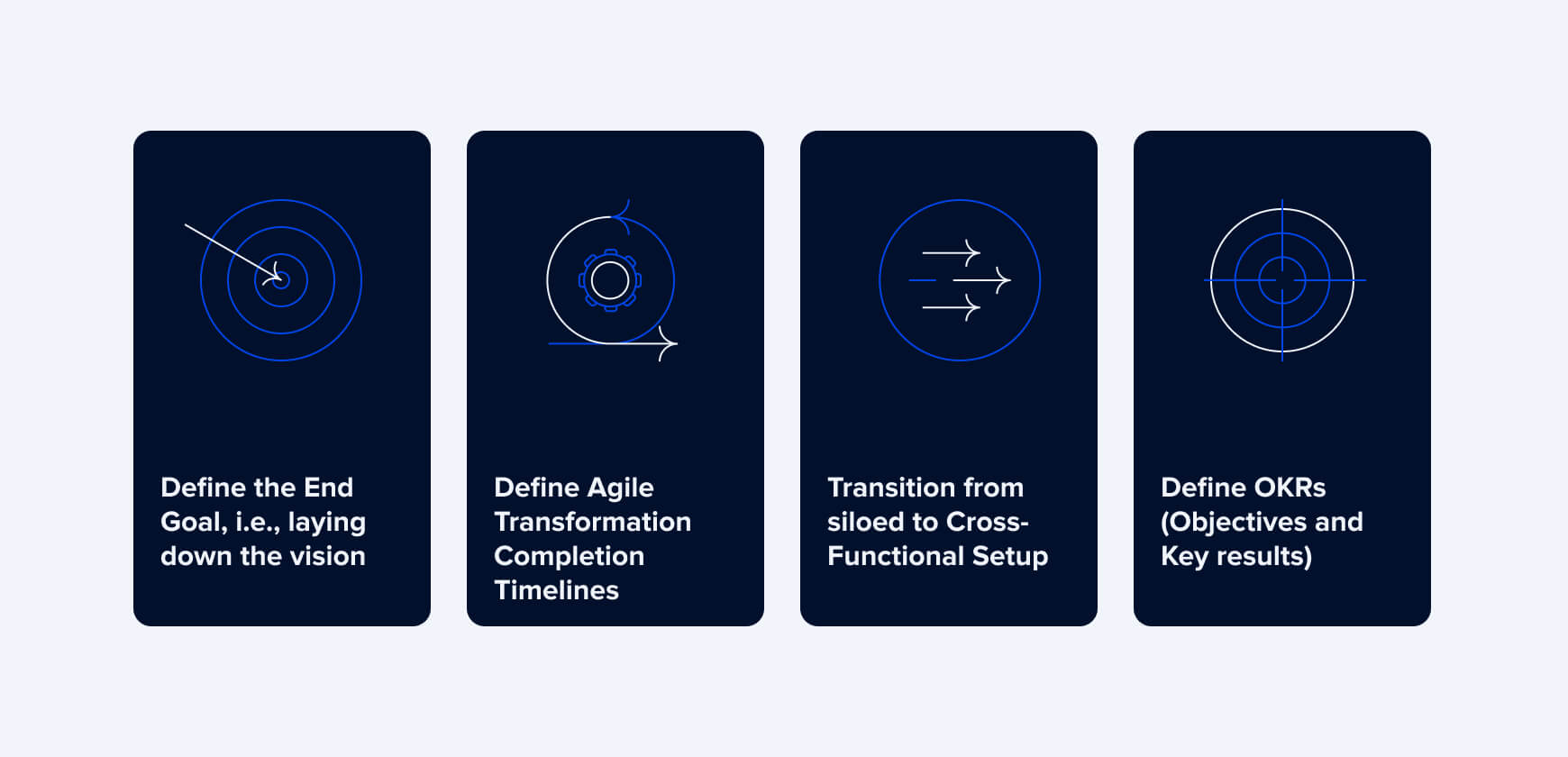
In the current highly competitive business environment, companies and individuals are forced to invest in innovations and creativity to remain at the top of the competition. It increases the importance of changes and the significance of project management processes in any organisation.
Different approaches may be taken to achieve success because the project management process can vary greatly depending on the organisation and the project itself. It is up to the project manager to identify which strategy will work best based on their specific circumstances.

Waterfall and Agile approaches are the two most popular ways of project implementation in today's business environment. Both methodologies can help organisations achieve strategic alignment by providing leadership and direction to projects while ensuring a proper plan is in place for either developing an application or executing the company's strategic objectives. Let's look closely at waterfall project management vs Agile to see which would be best for your organisation.
Agile vs waterfall: the pros and cons of each

Waterfall approach
The waterfall approach is a linear process in which all stages and phases of the project management cycle follow each other in sequence. It depends heavily on predictable instruments and experience, meaning that each project must follow the same cycle and process regardless of the nature of the organisation or project deliverables.
The primary phases of this process include feasibility, planning, designing, building, testing, production and support. This method is most appropriate for projects with little to no chance that the scope will change and impact the business or project.
The waterfall approach relies heavily on proper planning and evaluation in the development stage. This streamlined process makes it challenging to implement changes if the need arises but allows project managers to focus on other tasks since the team works effectively without guidance or supervision unless a problem occurs.

Key benefits of the waterfall approach
- A clear sense of direction – everything in this approach is pre-planned. Every team member deeply understands their roles and responsibilities and the project necessities. As a result, it is easier for all stakeholders to work efficiently and effectively with minimal management and supervision.
- High level of control – the project manager has the ultimate power and authority in a traditional setup. They often adopt a hierarchical structure where power and authority trickle down from top management to lower management. It ensures that only the manager can approve significant changes in the project management process, preventing deviations from the original project scope.
- A single point of accountability – given that all crucial decisions go through the project manager, they are ultimately responsible for the success or failure of the project. This way, stakeholders always know who to approach to get updates on progress rather than holding various team members accountable for different aspects of the project.
- Clear documentation – it is one of the significant pillars of the waterfall project approach. Having all the documentation in place is essential to standardising and making the process successful. It can be used as a point of reference for future projects, ensuring they are carried out effectively.
Agile approach
Unlike the waterfall approach, which focuses on upfront planning, cost, scope and time, the Agile approach pays closer attention to project team collaboration, customer collaboration and flexibility. It is best characterised as an iterative methodology that improves partner coordination by incorporating client input into the dynamic process. The Agile approach allows for flexibility and experimentation.
This approach allows for making changes in the planning and implementation process. By paying closer attention to adjustments, the Agile approach helps to deliver positive results instead of simply following an inflexible method that may not produce the best outcome.
The adaptability of the planning process is one of the critical features of the Agile approach, as it allows for quickly incorporating changes into the project's scope. This makes it the most popular methodology in today's business environment. Despite its benefits, the Agile approach can potentially devote a lot of time to communications between team members and stakeholders and lead to confusion if not managed correctly.
Businesses that have adopted Agile software development methods may sometimes find themselves experiencing decreased technical motivation and productivity. Our blog outlines the possible reasons for this problem, as well as potential solutions: Why Agile Doesn’t Work And 6 Ways You Can Fix This

Two of the most well-known Agile frameworks are Scum and Kanban. They both work with independent direction, which helps to keep the focus more on the customer and use available resources to track the task's progress at each stage quickly.
Top benefits of Agile project management
- Higher flexibility – the fact that the Agile approach is not pre-planned in advance makes it flexible and able to adapt to changes, increasing the chances of success. The project is divided into smaller sprints, making identifying and implementing necessary changes easier.
- Better transparency – this methodology ensures that all stakeholders have an influence and a say in decision-making. This way, everyone is kept up to date with the sprint progress. Having everyone on board makes it easier to decide as a team and share responsibility for the project and is crucial for enhancing transparency.
- Effective collaboration – the success of this approach is based on its ability to share information regularly. There is no compartmentalisation of information as it flows to all members across all organisational levels. It ensures that everyone's opinions and feelings matter, resulting in a more effective organisation.
- Efficient problem solving – by having all team members play a significant role in solving issues and problems, you'll find that things become more efficient and effective. Plus, team members can make substantial changes without needing approval from the manager – saving valuable time in the process.
If you would like to explore the advantages of Agile methodology in greater detail, as well as any potential challenges and disadvantages, check out this blog post: Six Key Benefits of Agile Development
Handling risks: waterfall project management vs Agile
Risk management is an integral part of any project management methodology. However, each project management methodology takes a different risk management approach. Both waterfall methodology and Agile framework apply the risk management cycle at the primary level with four main phases: risk identification, evaluation, handling, and control. Here is a deep dive into the different features of waterfall project management vs Agile and their risk management approaches.

Waterfall methodology risk management
Waterfall applies predictive risk management, emphasising risk forecasting and analysis. The project manager and team establish the probability of occurrence and expected project effect on individual risks. By identifying and prioritising risks early on, the project team and organisation can address them before they develop into critical problems. Waterfall risk management attempts to identify and assess project risks and opportunities before or at the start of the project.
Unfortunately, this approach prioritises bulk risk identification and evaluation at the beginning of the project, which reduces the likelihood of making critical changes throughout the entire process. Since it is impossible to predict the future, this approach creates an inaccurate risk plan. Additionally, project managers and developers are motivated to deliver based on a plan, putting pressure on them to ignore risks until they become a problem.
Agile risk management
Agile methodology's adaptive risk management approach keeps risks small by defining and delivering system functionality iteratively and continuously. As a result, the scrum master with the team can easily handle any potential hazards. Additionally, because Scrum-based projects are constantly monitored as they evolve, the likelihood of a significant impact from any individual risk is negligible.
While this approach encourages risk identification and evaluation at the start of each sprint, the planning is short-term. It allows the project team to identify new risks as they move to the next phase of short-term planning. Besides, the risk management and treatment process is part of development instead of a separate process, which increases the probability of success by eliminating any complexities.
By adopting this approach, teams can integrate risk management and control into their everyday workflows. It helps to encourage better identification and evaluation of risks, ultimately increasing the chances of success.
Agile transformation: everything you need to know
Agile transformation is essential for successful Agile adoption. It's all about transitioning to and implementing an Agile way of thinking and working within an organisation. Agile transformation brings the philosophy associated with Agile frameworks software development across all departments and teams in an organisation and applies it to all collaborations, processes, and measurements.
In other words, an Agile transformation is not simply about changing how software is developed within an organisation. It is much more than that; it represents a great opportunity to change the entire organisation. It can involve creating highly effective cross-functional or self-organised teams that achieve predetermined goals. If you want to learn more about enterprise-wide Agile transformation, we have a blog post discussing this topic: 10 Steps for Migrating to Agile Enterprise Architecture
There is no one-size-fits-all answer to how long an Agile transformation can take. However, encouraging self-organising teams is critical to a successful transformation, and this may require more time. The team should be free to work in the way that suits them best but always strive for iterative improvement. Therefore, the timeframe for transformation will vary depending on factors such as the training and experience of individual players and teams.

What is the Agile transformation roadmap?
An Agile transformation project is like any other project that introduces significant changes to an organisation or team. So an Agile transformation roadmap is a great way to communicate the vision and phases an organisation wants to go through in its journey towards becoming more Agile.
However, it is worth noting that an Agile transformation project is complex and comprehensive and often includes an Agile transformation roadmap as a discrete roadmap milestone. Thus, Agile transformation project plans can be created based on whether or not a company is scaling its transformation.

5 steps to success with Agile transformation
Agile transformation is essential for improving organisational flexibility, speed, collaboration, communication, and cross-functional setups. Several basic steps characterise this process:
1. Identify where is your organisation
Identify where your organisation is – establishing and understanding the company's current state helps determine if the stakeholders are excited about the change and their expectations. It is also vital to understand the status quo in the organisation by collecting data and facts about the company.
2. Assess your organisation
An organisational assessment can help you understand a company's inner workings, including its structure, decision-making criteria, leadership approaches and corporate culture. This data is crucial for defining objectives, systems and strategies that can lead to an Agile transformation.
3. Building a leadership team
The next step is selecting qualified and skilled individuals who can achieve transformation. It is essential to have a clear strategy and leadership team in place to drive significant changes forward.
4. Providing training and workshops
This phase focuses on training leadership, teams or technical subjects so that everyone involved have the skills and knowledge to embrace an Agile approach and be successful.
5. Coaching and consulting
Although training provides theoretical knowledge about Agile practices, hands-on coaching is vital for building on that foundation and assisting people and teams in establishing the habits necessary for becoming Agile. Without proper coaching, there is little chance of success.

Conclusions
To sum up, when deciding between the waterfall approach and Agile frameworks, it is essential to consider the project's goals, budget, and timeline. The comparison of the waterfall project management vs Agile demonstrates that the Agile approach is more flexible and adaptable. In contrast, the waterfall approach is more focused on planning and control.
No matter which method you decide to use, it is crucial that your team be well-trained and follow the principles of project management to ensure a successful outcome.
If you need help deciding which project management approach will work best for your company, you can rely on ELEKS to guide you through your entire SDLC.

Related Insights








The breadth of knowledge and understanding that ELEKS has within its walls allows us to leverage that expertise to make superior deliverables for our customers. When you work with ELEKS, you are working with the top 1% of the aptitude and engineering excellence of the whole country.

Right from the start, we really liked ELEKS’ commitment and engagement. They came to us with their best people to try to understand our context, our business idea, and developed the first prototype with us. They were very professional and very customer oriented. I think, without ELEKS it probably would not have been possible to have such a successful product in such a short period of time.

ELEKS has been involved in the development of a number of our consumer-facing websites and mobile applications that allow our customers to easily track their shipments, get the information they need as well as stay in touch with us. We’ve appreciated the level of ELEKS’ expertise, responsiveness and attention to details.

